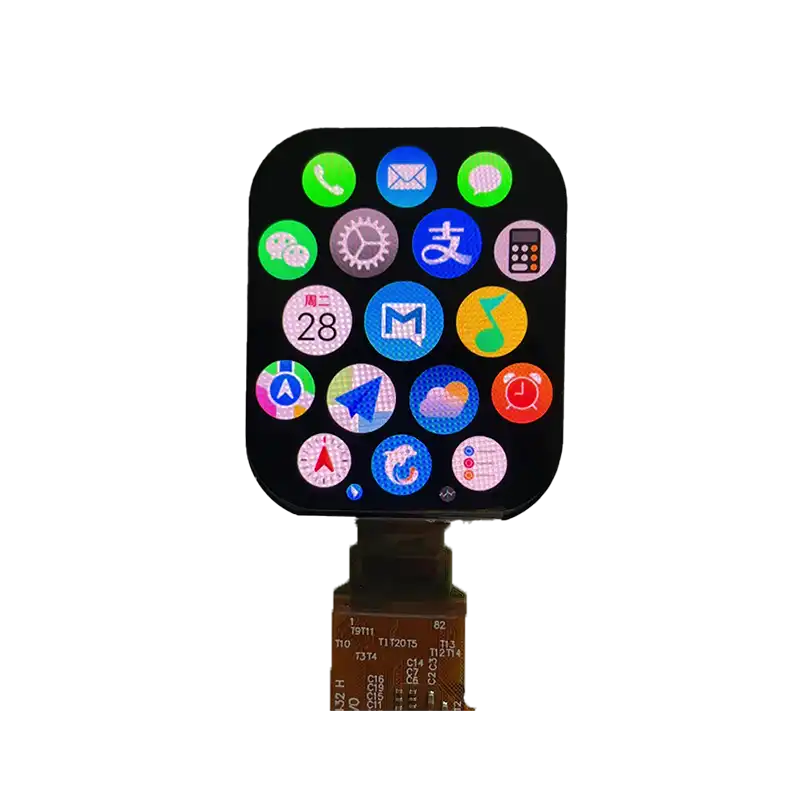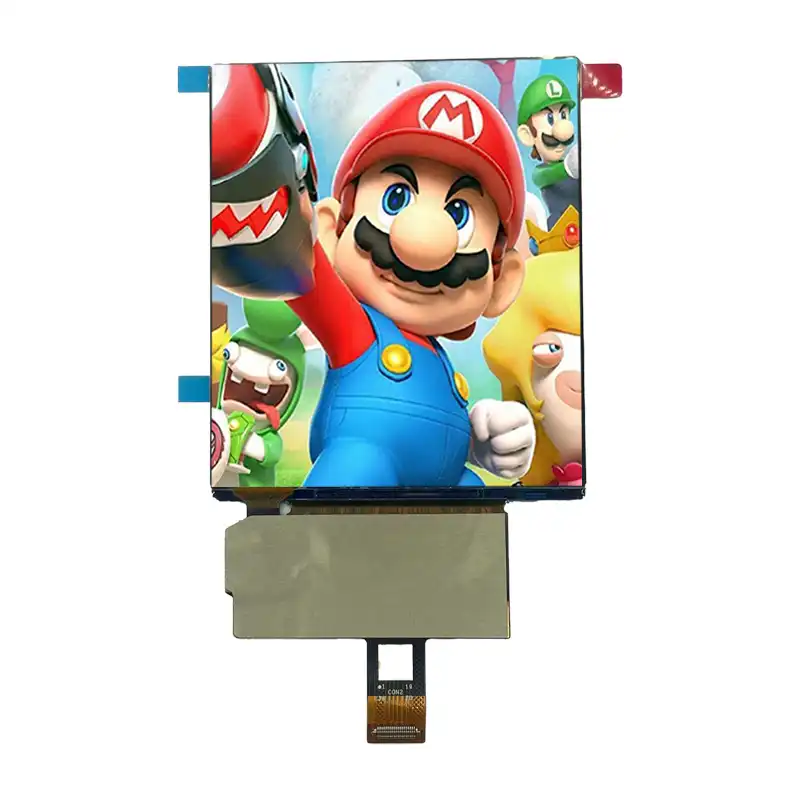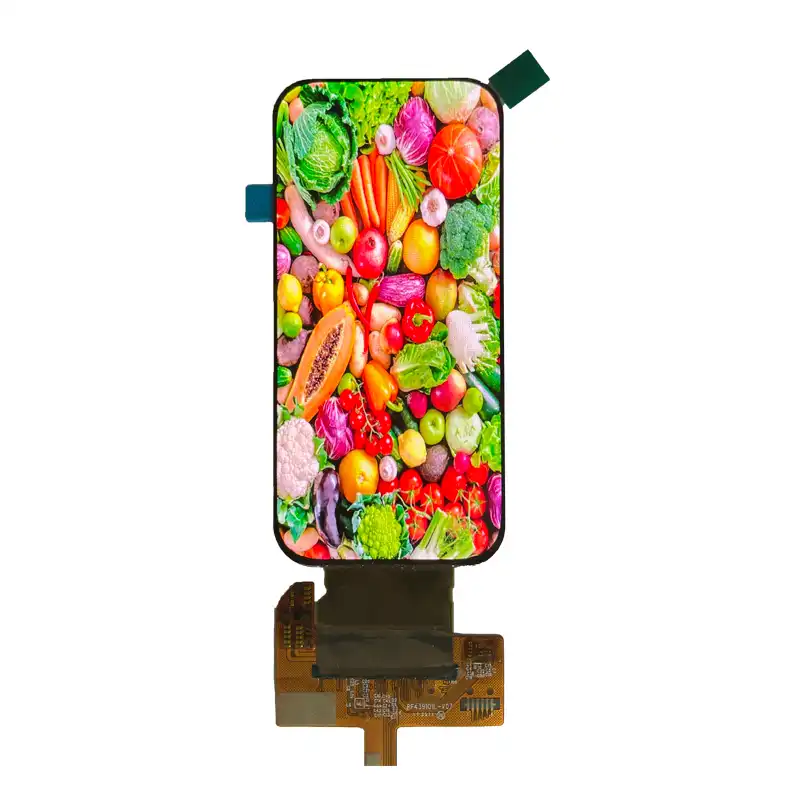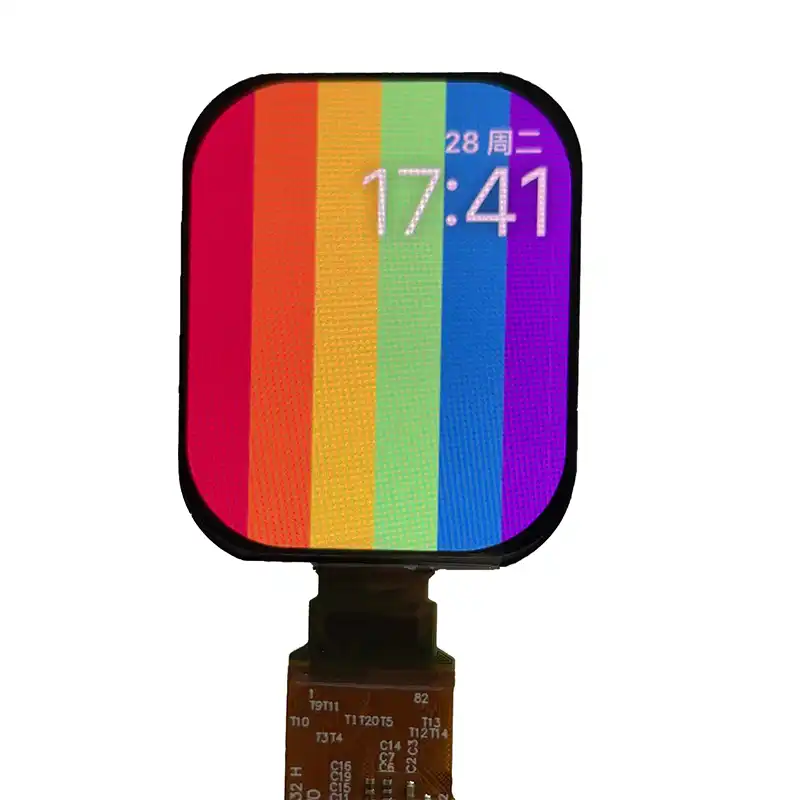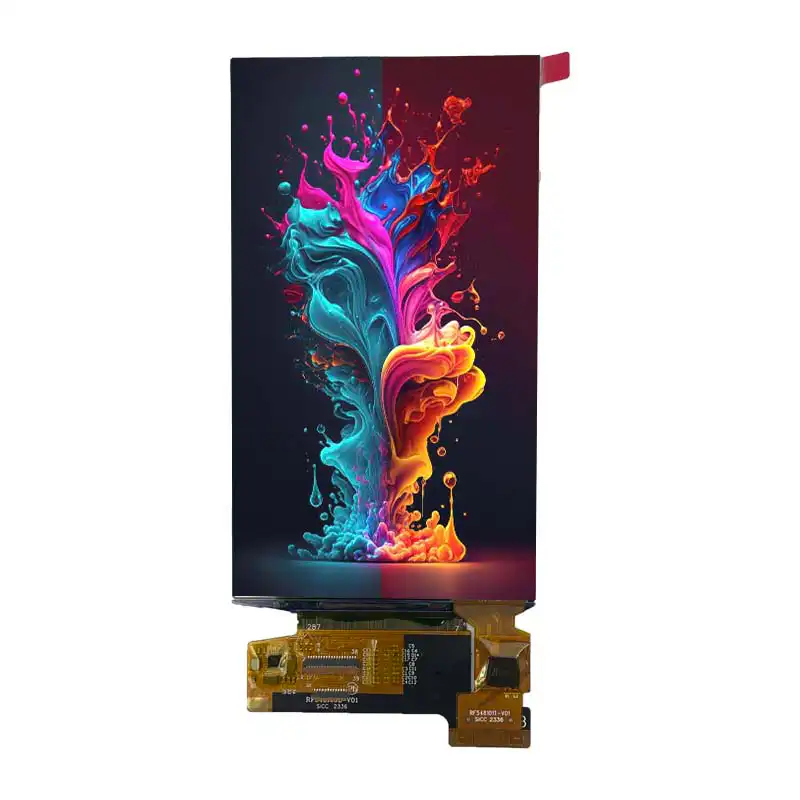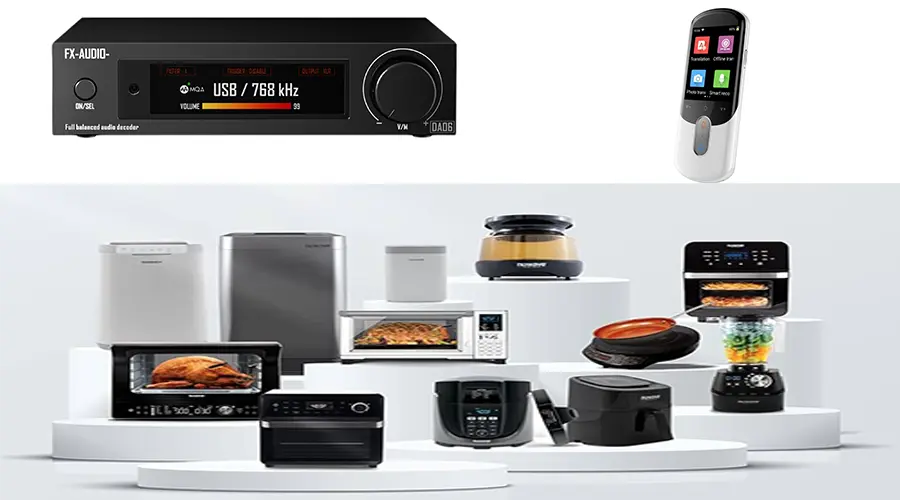Introduction to the 4.39inch AMOLED Display Module
The 4.39inch AMOLED (Active-Matrix Organic Light-Emitting Diode) display module is a next-generation screen solution designed for applications requiring high resolution, rich colors, and low power consumption.
This display technology leverages self-emitting pixels that eliminate the need for backlighting, resulting in deeper blacks, wider viewing angles, and higher contrast ratios. The 4.39inch AMOLED display is particularly suitable for wearable electronics, smart home devices, medical instruments, and industrial human-machine interfaces (HMI).
With a full HD+ resolution of 568(W) × 1210(H), this display offers a pixel density of approximately 320 PPI, ensuring crystal-clear visuals even at close distances. Its slim form factor and flexible mounting options make it ideal for compact designs where space is limited.
In this guide, we will explore the core specifications, electrical characteristics, optical performance, interface design, reliability testing, and application scenarios of the 4.39inch AMOLED display module. We will also address frequently asked questions and provide contact information for further support.
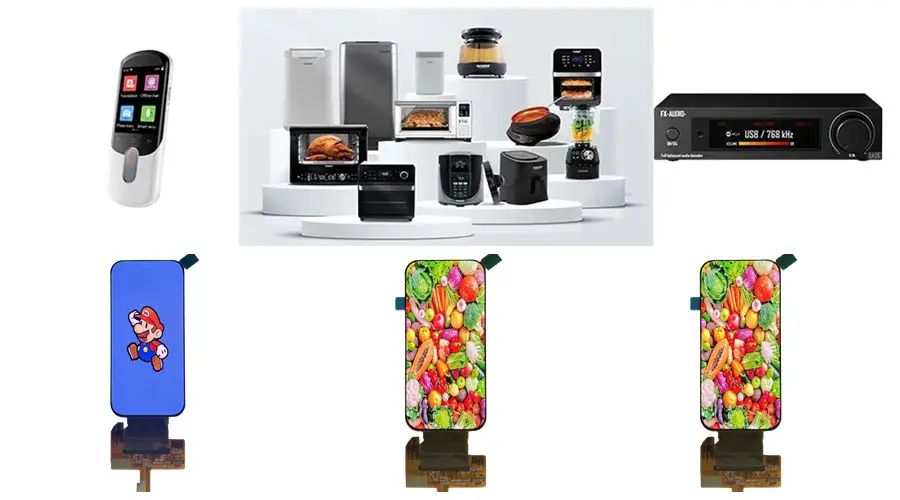
Core Specifications of the 4.39inch AMOLED Module
The 4.39inch AMOLED display module offers cutting-edge performance tailored for modern electronic devices. Below are the key technical specifications:
| Parameter | Value | Description |
|---|---|---|
| Screen Size | 4.39 inch | Diagonal size of the display panel |
| Resolution | 568(W) × 1210(H) | FHD+ resolution with pixel density ~320 PPI |
| Aspect Ratio | ~2.13:1 | Portrait-oriented aspect ratio |
| Pixel Pitch | 83.4μm × 83.4μm | Precision pixel layout |
| Color Depth | 16.7M Colors | Supports full RGB color gamut |
| Display Type | AMOLED | Self-luminous organic LED |
| Driver IC | SD5207 | Integrated driver for OLED control |
| Touch Controller | CST3530 | Capacitive touch support with I²C interface |
| Interface | MIPI D-PHY 2 Lane | High-speed digital data transmission |
The SD5207 driver IC provides precise control over pixel brightness and refresh rates, while the CST3530 touch controller enables accurate multi-touch detection. The MIPI D-PHY 2 Lane interface ensures fast and stable communication between the host processor and the display module.
Interface Design and Pin Assignments
The module utilizes a MIPI D-PHY 2 Lane interface for high-speed communication with the host controller. It supports both command and video modes, enabling flexibility in application development.
Below is a breakdown of the pin assignments for the FPC connector:
| Pin No. | Signal Name | Description |
|---|---|---|
| 1–3 | ELVDD | Positive voltage supply for OLED |
| 4–6 | ELVSS | Negative voltage supply for OLED |
| 8 | AVDD | Power for internal charge pump |
| 12,14,24,26 | D0P/D0N/D1P/D1N | Data lanes for MIPI interface |
| 18,20 | CLKP/CLKN | Clock lines for MIPI synchronization |
| 30 | RESX | Reset signal for display driver |
| 31 | VCI | Logic voltage supply |
Proper connection of these pins is essential for stable operation. The ELVDD and ELVSS pins provide power to the OLED layer, while AVDD powers the internal charge pump used for generating high voltages required by the OLED pixels. The MIPI differential pairs (D0P/D0N and D1P/D1N) carry display data, and the clock lines (CLKP/CLKN) ensure synchronous data transfer.
Electrical Characteristics
To ensure optimal operation and longevity, it's important to adhere to the specified electrical parameters:
| Parameter | Symbol | Min | Typ | Max | Unit |
|---|---|---|---|---|---|
| Logic Supply Voltage | VDDIO | 1.65 | 1.8 | 1.98 | V |
| Analog Power Supply | VCI | 2.65 | 3.0 | 3.6 | V |
| Charge Pump Voltage | AVDD | - | 7.6 | - | V |
| OLED Positive Voltage | ELVDD | - | 4.6 | - | V |
| OLED Negative Voltage | ELVSS | - | -3.5 | - | V |
These values must be maintained within the specified range during normal operation. Exceeding them can lead to reduced lifespan or permanent damage to the display. It is recommended to use regulated power supplies and include filtering capacitors near the power input pins to minimize noise and voltage fluctuations.
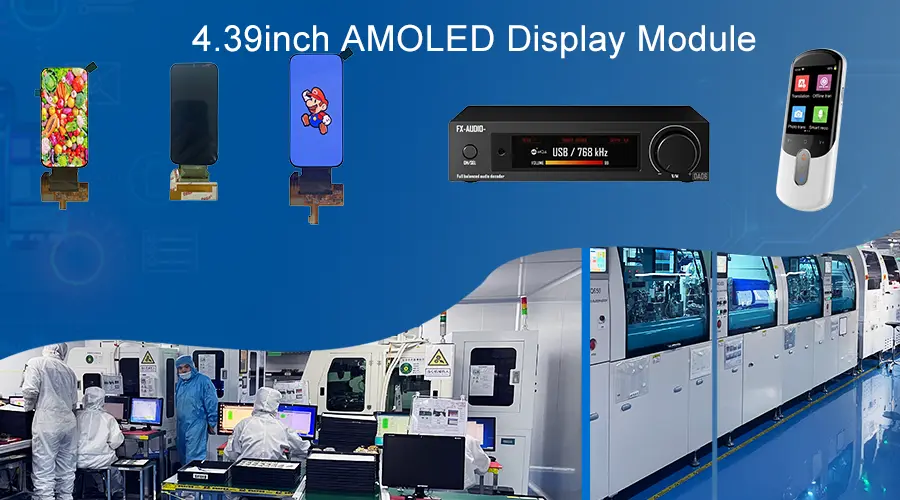
Optical Performance Metrics
The optical performance of the 4.39inch AMOLED display ensures excellent visibility under various lighting conditions:
| Parameter | Condition | Min | Typ | Max | Unit |
|---|---|---|---|---|---|
| Luminance | White screen at full brightness | 550 | 600 | - | nits |
| Contrast Ratio | CR ≥ 10 | - | 100000:1 | - | - |
| Viewing Angle | CR ≥ 10 | 80 | 85 | - | °C |
| NTSC Color Gamut | - | 97 | 100 | - | % |
| Lifetime (White Screen) | At 25°C | 250 | - | - | hrs |
The high luminance and contrast ratio make this display highly readable in bright environments. The wide viewing angle ensures consistent image quality from all directions, which is especially useful in public-facing displays such as kiosks or retail signage. The NTSC color gamut coverage of up to 100% means that the display can reproduce a broad range of colors accurately, making it suitable for multimedia and professional imaging applications.
Reliability and Environmental Testing
The module undergoes extensive testing to ensure durability and performance across different environments:
High-Temp Operation: +70°C for 240 hours
Low-Temp Operation: -30°C for 240 hours
Humidity Test: 60°C / 90% RH for 240 hours
Thermal Shock: -40°C ↔ +80°C, 30 cycles
ESD Protection: Air discharge ±8kV, Contact discharge ±4kV
These tests guarantee long-term stability and suitability for use in both indoor and outdoor environments. The display maintains functionality even after exposure to extreme temperatures and humidity levels, making it suitable for industrial, automotive, and outdoor applications. Electrostatic discharge (ESD) protection ensures that the module remains operational in environments prone to static electricity buildup.
Application Scenarios
The 4.39inch AMOLED display module is highly versatile and suitable for a variety of embedded and wearable applications:
Smart Wearables: Smartwatches, fitness bands, and health monitoring devices benefit from the high contrast and compact form factor.
Medical Devices: Vital signs monitors, portable ECG machines, and diagnostic tools require clear and accurate visuals — this module delivers.
Industrial Control Panels: Used in HMI (Human Machine Interface) displays, process control units, and automation systems.
Consumer Electronics: From smart home hubs to audio players, the AMOLED enhances user experience with vivid visuals.
Automotive Displays: Instrument clusters and dashboard interfaces can integrate this display for better readability and aesthetics.
Due to its energy-efficient design, the module is well-suited for battery-powered devices. The ability to enter low-power modes allows developers to optimize power consumption based on usage patterns. Whether used in consumer products or industrial equipment, the 4.39inch AMOLED display offers an exceptional combination of performance, clarity, and versatility.
Frequently Asked Questions (FAQ)
What is the maximum operating temperature?
The module is rated for continuous operation up to +70°C, making it suitable for most ambient and semi-industrial environments.
Can this display be used outdoors?
Yes, thanks to its high luminance of up to 600 nits and wide viewing angles, the display remains readable even under direct sunlight.
Is there built-in touch functionality?
Absolutely. The CST3530 capacitive touch controller enables multi-touch functionality via the I²C interface, supporting gestures like swipe and pinch-to-zoom.
How long does the display last?
Under standard test conditions (white screen at 25°C), the expected lifespan is approximately 250 hours before significant degradation occurs.
What kind of microcontroller or platform works best with this module?
It is compatible with popular platforms such as STM32, ESP32, Raspberry Pi, and custom FPGA-based controllers using the MIPI D-PHY protocol.
Does the module support sleep mode or power-saving features?
Yes, the SD5207 driver supports multiple power-saving modes including deep sleep, idle mode, and partial display updates, which help extend battery life in mobile applications.
Contact Us
If you have any questions about the 4.39inch AMOLED display module or need assistance with integration, feel free to reach out to our support team.
Email: info@blhlcd.com
WhatsApp: +86 17748574559
We offer sample modules, datasheets, and development kits upon request. Our engineers are ready to assist with hardware compatibility, firmware integration, and custom design requirements.
Latest articles
-
Why 1–2" AMOLEDs Are Key to AR/XR in 2025
Why 1–2 Inch AMOLED Displays Are Becoming Essential in the AR/XR Boom (2025 Industry Insight)body {f
-
Understanding OLED Display Technology: Principles, Performance & Applications
OLED (Organic Light Emitting Diode) displays are a class of self-emissive display technology in whic
-
From Wearables to AR Glasses – How OLED Displays Are Redefining Visual Experiences in 2025
By 2025, OLED (Organic Light-Emitting Diode) technology has transitioned from luxury smartphone disp
-
Stretched Bar LCD Displays for Retail: Boost Sales & Engagement in Supermarkets
Discover how stretched bar LCD displays enhance supermarket shelf-edge marketing, drive sales, reduc
-
Stretched LCD Solutions for Restaurants and Hospitality Venues
Stretched LCDs offer sleek, high-brightness displays perfect for restaurant menus and hospitality si
Recommended products
-
2.06-inch OLED Display | 410×502 Resolution | 600 Nits | SPI Screen
The 2.06-inch AMOLED display module is designed specifically for harsh industrial environments, feat
-
3.92 INCH OLED Screen I2C Interface 1080 × 1240 Resolution
Product Specifications: BRO392001AResolution: 1080x1024Operating Voltage Range: 28VScreen Size: 3.92
-
4.39 INCH OLED display module I2C Interface 568×1210 Resolution
The 4.39-inch AMOLED display module (model BR439102-A1) introduced by (Shenzhen Brownopto Technology
-
1.93 INCH OLED Panel I2C 368x448 Industrial-Grade Panel
Shenzhen Brownopto Technology’s 1.93-inch AMOLED module (Model BR193103-A1) features a core advantag
-
5.48 INCH AMOLED Display Module - 1080x1920 I2C, MIPI DSI, Industrial
Product Specifications: BRO548001AResolution: 1080x1920Operating Voltage Range: 2.8VScreen Size: 5.4

